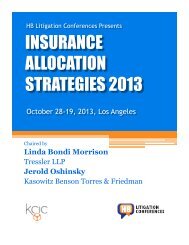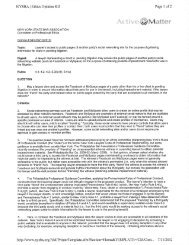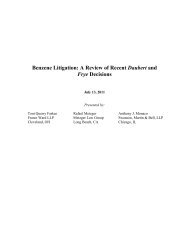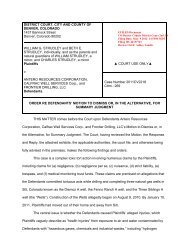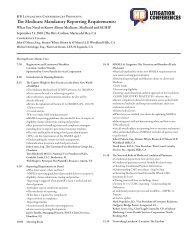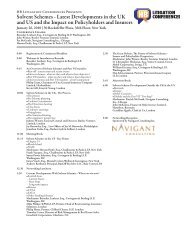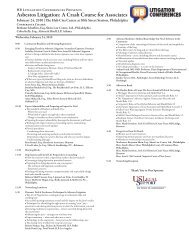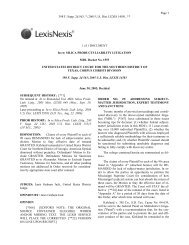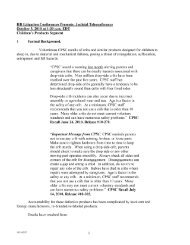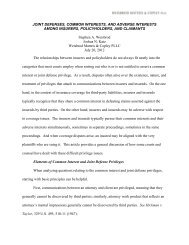Is My Drywall Chinese? - HB Litigation Conferences
Is My Drywall Chinese? - HB Litigation Conferences
Is My Drywall Chinese? - HB Litigation Conferences
Create successful ePaper yourself
Turn your PDF publications into a flip-book with our unique Google optimized e-Paper software.
allocating between remediation and stigma.<br />
This loss in value becomes, in effect, an<br />
adjustment and can be quantified using<br />
methods used to extract any other appraisal<br />
adjustment.<br />
Stigma adjustment extraction<br />
The process of calculating starts with identifying<br />
transactional data for impaired properties. This<br />
language is purposefully inclusive as it applies<br />
to both sale and lease transactions and to both<br />
residential and non‐residential properties.<br />
Because of its predominance in the domain of<br />
<strong>Chinese</strong> drywall impairment, we will continue<br />
this example with residential properties and<br />
explore the how stigma may impact the value of<br />
the fee simple interest in these properties.<br />
Any methodology which attempts to extract<br />
stigma losses from sales prices critically<br />
depends on the details of the underlying<br />
transactions. For example, buyers (or sellers)<br />
are not well aware of the problem, or not fully<br />
appreciative of the long‐term impact, the sales<br />
price will not reflect an actual arms‐length<br />
transaction.<br />
Matched pairs<br />
When analyzing a small collection of impaired<br />
comparable sales, the percentage loss in value<br />
may be directly measured using matched pair<br />
methodology. This methodology will result in a<br />
set of pairs that can be analyzed for differences<br />
based upon the circumstances of this<br />
impairment. From this set, the appraiser can<br />
exercise judgment to determine where, within<br />
the range of value loss experienced by the set<br />
of pairs, the circumstances of the immediate<br />
appraisal indicated that the loss in value for the<br />
subject property should lie.<br />
For this methodology to be successful, it is<br />
important to find sales of impaired properties<br />
that bracket the impairment of the subject<br />
property and that are as comparable as possible<br />
to the subject property. If appraising multiple<br />
SUITE 650, FOURTH AVENUE<br />
SEATTLE, WASHINGTON 98121<br />
PHONE 206-623-2935 FAX 206-623-2985<br />
HTTP://WWW.GREENFIELDADVISORS.COM<br />
<strong>Chinese</strong> <strong>Drywall</strong><br />
June 5, 2009<br />
Page 6<br />
heterogeneous subject properties, multiple sets<br />
of paired sales may be required.<br />
When the number of subject properties<br />
becomes large, some sort of expert system or<br />
valuation matrix will need to be used.<br />
Mass appraisal methodology<br />
When analyzing many impaired properties,<br />
mass appraisal methodology such as expert<br />
systems, hedonic modeling, or hybrid<br />
comparable selection and hedonic modeling<br />
systems can be used. These same methods can<br />
be used to extract adjustments. When using<br />
regression analysis, a factor is statistically<br />
derived for each variable being modeled.<br />
Statistics relative to the calculation of each<br />
factor are calculated in the regression output<br />
results. The analyst can then determine if an<br />
adjustment is statistically significant or not.<br />
Another way that the percent loss in value of an<br />
impairment can be captured can occur using a<br />
few modeling techniques.<br />
1. The model can be built using sales of<br />
unimpaired properties and then used to<br />
calculate the unimpaired values of<br />
impaired properties. When so used, the<br />
difference between the calculated value<br />
and the actual sales price is the loss in<br />
value.<br />
2. The model can be built using a<br />
"dummy" variable that indicates<br />
whether a property is or is not<br />
impaired. The contents of this field in<br />
the data would be zero or one, with<br />
zero representing no and one<br />
representing yes. The regression<br />
equation output presents a coefficient<br />
for this variable along with statistics<br />
that allow the analyst to determine if<br />
the variable is statistically significant.<br />
This methodology yields a dollar<br />
amount when the dependent variable<br />
(price) is expressed as a dollar amount<br />
and really only suitable when the



